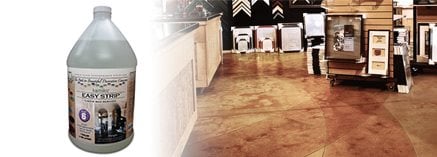- Concrete Sealers
- Comparison Chart of Concrete Sealers
- Buying Tips for Concrete Sealer Products
- Concrete Sealer Reviews: Sealer products other contractors use and recommend
- Common Questions about Concrete Sealers
- How to Remove Concrete Sealer
- Types of Sealers
- Acrylic Sealers
- Epoxy Sealers
- Penetrating Sealers
- Polyurethane Sealers
- Polyaspartic Sealers
- Application Surface
- Driveway Sealer
- Sealers for Stamped Concrete
- Concrete Floor Sealers
- Concrete Countertop Sealers
- Pool Deck Sealer
- Exposed Aggregate Sealer
The Best Method for Stripping Sealers
I recently spoke at the World of Concrete in Las Vegas on the topic of troubleshooting decorative concrete. During the Q&A session, a popular subject was stripping sealers, specifically what is the best way to go about it and what are the best products on the market to accomplish the task. So this installment will deal with just those questions.
Before deciding the best way to remove a sealer, you need to know what type of sealer you are stripping. Obviously, not all sealers are alike. Thicker sealers (polyurethanes and epoxies) perform better, but they will take longer to remove than thinner sealers (acrylics).
There are two general methods for stripping sealers: chemical and mechanical. Chemical strippers utilize chemicals to break down the polymer structure of a sealer. They permanently destroy the sealer, typically turning it into sludge. Mechanical removal of sealers involves using equipment to grind or blast off the sealer. Shotblasting, bead blasting, scarifying and grinding are common mechanical methods for sealer removal. The important thing when using mechanical means to remove sealers is to avoid damaging the substrate below. This is where you should use softer shot or beads, like finely ground corn husks or seed hulls.
 Easy Strip™ Wax Stripper
Water base, low VOC, Biodegradable, easy cleanup
Easy Strip™ Wax Stripper
Water base, low VOC, Biodegradable, easy cleanup
 Eco Paint & Sealer Stripper
VOC compliant in all 50 states
Eco Paint & Sealer Stripper
VOC compliant in all 50 states
 Coating Removal - Brickfrom Strip-It
Environmentally sound and user-safe stripper
Coating Removal - Brickfrom Strip-It
Environmentally sound and user-safe stripper
 600 GL Coatings Remover
Removes multiple layers in single application.
600 GL Coatings Remover
Removes multiple layers in single application.
 Nock-Off
Biodegradable commercial grade coatings stripper.
Nock-Off
Biodegradable commercial grade coatings stripper.
By far the most popular and effective method of removing any type of sealer is to use a chemical stripper. This is especially true with decorative concrete, since maintaining the profile and color of the concrete is critical. Chemical strippers have undergone a major transformation in recent years. The desire for more environmentally friendly chemicals has led to the creation of a new family of strippers that are easy on the environment. These include citrus and soy-based strippers that use natural esters and oils to break down the sealer. These natural strippers have little impact on the environment, but they take longer to work. More aggressive chemical strippers based on methylene chloride work much faster. These strippers have been used for years to remove coatings and paints, but they are volatile and potentially hazardous -- to both the environment and the applicator. So it really comes down to time vs. environmental impact and safety.
The process of stripping by chemical means requires time and keeping the stripper active, or wet. Chemical strippers only work when they are active. Most strippers are in a gel form, which helps keep them active longer. The slower-acting natural strippers require more time to work and thus keeping them moist is critical. A great trick to keeping a stripper active is to cover the stripper with a damp cotton bed sheet. The thin, damp covering will keep the stripper moist and help to absorb the dissolved sealer for easier removal. This process may need to be repeated, depending on the sealer type, stripper type and surface. Stamped concrete, with its texture and grooves, is by far the most difficult surface to strip.
Once the sealer has dissolved, a good cleaning will be necessary after stripping, even if a bed sheet was used to pull up the sealer. Remove the sludge with high-pressure warm water followed by cleaning with soap and water to remove any remaining residue. A clean water rinse, followed by plenty of drying time, is critical before reapplying a new coat of sealer.
Author Chris Sullivan, ConcreteNetwork.com technical expert and vice president of sales and marketing for ChemSystems Inc.
Return to Concrete Cleaning




